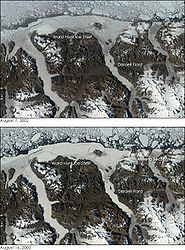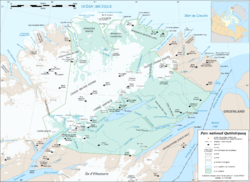- Ward Hunt Island
-
Ward Hunt Island NASA-Satellitenbilder von 2002 Gewässer Arktischer Ozean Inselgruppe Königin-Elisabeth-Inseln Geographische Lage 83° 4′ 47″ N, 74° 8′ 17″ W83.079722222222-74.138055555556415Koordinaten: 83° 4′ 47″ N, 74° 8′ 17″ W Länge 6,5 km Breite 3,3 km Fläche 13,9 km² Höchste Erhebung Walker Hill
415 mEinwohner (unbewohnt) Karte zeigt Ward Hunt Island ganz im Norden Ward Hunt Island ist eine kleine Insel nördlich von Ellesmere Island in der kanadischen Arktis und gehört wie jene zu den Königin-Elisabeth-Inseln. Administrativ gehört die Insel zur Region Qikiqtaaluk des Territoriums Nunavut.
Inhaltsverzeichnis
Geographie
Ward Hunt Island liegt eingebettet in das Ward-Hunt-Schelfeis rund 5 km nördlich von Ellesmere Island in der Mündung des Disraeli-Fjords in den Arktischen Ozean. Die Nordspitze der Insel liegt bei 83° 5′ 50″ N, 74° 14′ 0″ W83.097222222222-74.233333333333. Damit ist die Insel eine der nördlichsten Landmassen Kanadas. Nur die Nordküste der Arthur Laing Peninsula um Kap Columbia liegt über eine Länge von rund 17 km weiter nördlich.
Die Insel ist 6,5 km lang, bis zu 3,3 km breit und teils vergletschert. Sie erreicht im Walker Hill im Westen eine Höhe von 415 m über dem Meer. Der Ostteil der Insel ist durch eine niedrigere, unbenannte Erhebung von 239 m gekennzeichnet. Zwischen den beiden Inselhälften liegt eine flache Mulde, sodass es sich um eine Doppelinsel handelt. Im Gegensatz zum Nordteil von Ellesmere Island ist Ward Hunt Island kein Bestandteil des Quttinirpaaq-Nationalparks. Eine Ausweitung des Nationalparks auf das Gebiet der Insel in den nächsten Jahren ist jedoch geplant.[1]
Die Gebäude der ehemaligen Forschungsstation Ward Hunt Island Camp stehen als Schutzhütten für die wenigen Besucher zur Verfügung. In der Nähe befindet sich ein Landeplatz für Twin Otter-Maschinen.
Geschichte
Die Insel wurde 1876 von Pelham Aldrich, einem Admiral der Royal Navy, entdeckt und von ihm nach George Ward Hunt, einem britischen Staatsmann, benannt.[2] Im Rahmen des Internationalen Geophysikalischen Jahres (1957–58) wurde auf Ward Hunt Island eine Wetterstation betrieben. 1959 errichtete das kanadische Defense Research Board (DRB) auf der Insel eine Forschungsstation die bis Ende der 1960er Jahre in Betrieb blieb.[3] Wegen ihrer – mit rund 770 km Distanz – relativen Nähe zum Nordpol war die Insel Ausgangspunkt zahlreicher Expeditionen zum Nordpol, beispielsweise der von Ralph Plaisted 1968.[4] 2002 und erneut 2008 brachen Teile des Ward-Hunt-Schelfeises in der Nähe der Insel ab. Ein Teil des Schelfeises setzte sich als sogenannte „Eisinsel“ vor der Nordküste von Ward Hunt Island fest. Dieser vorläufig stationäre, da auf Grund gelaufene Eisberg mit einer Flächenausdehnung von 35,9 km² wird auf einigen Karte irreführend wie Festland dargestellt. Er reicht mit seiner Nordspitze bei 83° 8′ 12″ N, 74° 6′ 49″ W83.136666666667-74.113611111111 zwar weiter nach Norden als Kap Columbia (83° 6′ 41″ N, 69° 57′ 30″ W83.111388888889-69.958333333333), ist aber kein Festland.
Weblinks
- NASA-Artikel über den Abbruch einer Kante des Ward-Hunt-Eisschelfs (englisch)
- NASA-Artikel über das gleiche Ereignis im August 2002 (englisch)
- Ein Foto der Insel
Einzelnachweise
- ↑ Parks Canada: Quttinirpaaq National Park of Canada Management Plan, Oktober 2009, S. 14
- ↑ George Nares, Narrative of a voyage to the Polar Sea during 1875-76. 2 Bde. London (1878)
- ↑ Quttinirpaaq National Park of Canada - History (englisch)
- ↑ Über die Plaisted-Expedition (englisch)
Kategorien:- Unbewohnte Insel
- Insel (Nunavut)
- Insel (Nordamerika)
- Insel (Arktischer Ozean)
- Insel der Königin-Elisabeth-Inseln
- Doppelinsel
Wikimedia Foundation.




